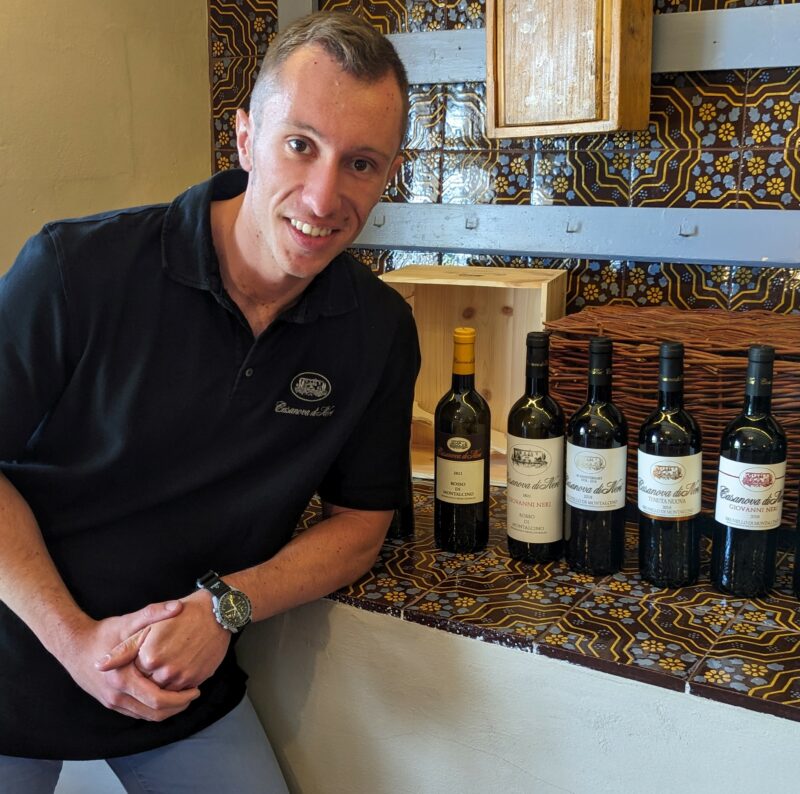Gianlorenzo Neri met us at his family’s Montalcino winery (Casanova di Neri) on a beautiful June morning in the heart of Tuscany.
Now Tuscany is everything that you’ve read and seen, only better because you are actually there. The rolling hillsides, the grapes ripening on the vine, quaint towns hundreds of years old, churches that are a thousand years old. Romance, history, culture and tradition animate each village.
But Casanova runs a little counter to this. Rather than having been handed down from one generation to the next for centuries, Casanova is barely 50 years old.
Gianlorenzo’s grandfather, Giovanni (a grain merchant at the time), founded what became Casanova di Neri in 1971. At that time, only about 30 wineries made the Brunello style of wine in accord with the strict standards of its production. (By contrast, today there are over 240.)
Giovanni clearly had found his calling. At first, he planted olive trees and wheat. But he had an instinctive sense as to what would be good land for the Sangiovese grape, the only grape allowed in Brunello wines.
Gianlorenzo showed us a map of the sites Giovanni and his son, Giacomo (Gianlorenzo’s dad), purchased over the years. One was an area called Cerretalto, a vineyard with its own microclimate not found elsewhere in Montalcino and a soil rich in iron and magnesium. Only in the best years is the Brunello di Montalcino Cerretalto produced. Like Cerretalto, all the other Casanova vineyards (79 acres in total) possess their own characteristics. As they like to say at Casanova, “Our Vineyards: Uniquely Diverse.”
During our two-hour tour of the grounds, barrel room and bottling area of Casanova, Gianlorenzo (who, along with his father and brother, Giovanni, run Casanova) showed us the riches and resources his winery has in abundance.
Contrary to most vineyards in California, the vines are dry farmed – no irrigation even though the weather can be brutal there. They also farm organically, which requires much more field work but is yielding outstanding results. No chemical fertilizers are used.
The winery has about 40 full-time employees and brings on extra help for harvest. Like many of the other wineries in Tuscany, the harvest workers hail mainly from Pakistan and India. Picking begins at 6 a.m. and continues to noon. The grapes are too warm after that to gather.
After harvesting and crushing the grapes, the juice (with two exceptions) is placed for fermentation in stainless steel tanks with automated punch downs. (The juice for Cerretalto and Giovanni Neri, a new style of Brunello, are fermented in oak barrels.) Wild yeast starts the fermentation process, which typically lasts 10 days. After aging in the barrel room, the wine is bottled.
All wines labelled Casanova di Neri are made from Casanova di Neri grapes. Because of the complexities and characteristics unique to each vineyard site, the Neri family decided to make five distinct bottlings — four Brunello di Montalcinos and one Super Tuscan.
Cerretalto, I have discussed. My impression is that this is the flagship wine when there is a bottled vintage. (When the grapes do not meet the exacting Neri standards, they become Brunello di Montalcino Etichetta Bianca, or White Label.) Wine Advocate (Robert Parker’s publication) gave the 2010 Cerretalto a perfect score of 100.
After that comes Brunello di Montalcino Tenuta Nuova (or, New Project or Property). The name comes from the fact that it “is a place where nobody planted Sangiovese before; Tenuta Nuova is the will of Casanova di Neri to produce a powerful yet drinkable Brunello with a high aging potential.” (This from Casanova’s website.) The 2010 Tenuta Nuova also got a perfect score; the 2001 was Wine Spectator’s Wine of the Year!
Their latest project is Giovanni Neri, named in honor of the Casanova di Neri’s founder. “A remarkable wine, a pure Sangiovese’s expression born out of an ancient, untamed vineyard with half-century-old vines spread over a great winegrowing terroir.”
About 30 or so years ago, a few of the more well-established Italian wineries decided to offer wine crafted in a completely new way. Grapes better known to hail from France, such as cabernet sauvignon and merlot, were used to make world-class Italian wine. But because these wines do not meet the standards of Chianti or Brunello, they are called Super Tuscans. Casanova di Neri has its own Super Tuscan, Pietradonice (which roughly translates to Onyx Stone). The vineyard is the site of an old onyx mine – thus the name for the wine.
In my next column I’ll tell you about our tasting of these wines.
Carl Kanowsky is an attorney, a fledgling baker, an enthusiastic cook and an expert wine drinker.
















